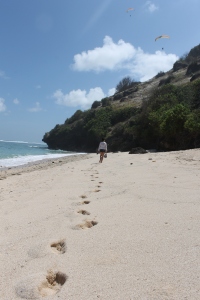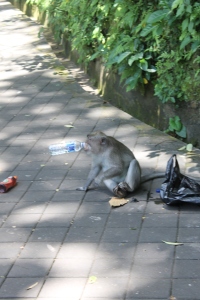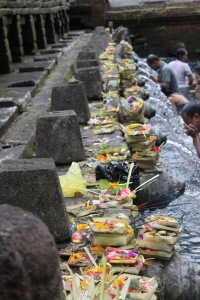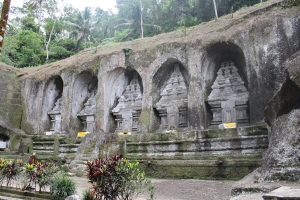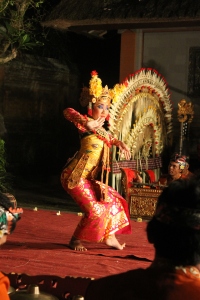Last week has been quite busy, as one of my friends from Germany came to visit Indonesia. I spent two consecutive weekends in Bali and four days in Yogyakarta, where I had the opportunity to dig deeper into my own culture, to say the least.
Upon our arrival in Bali, we spent a relaxing day at Pantai Gunung Payung near Nusa Dua (also known as Secret Beach). Soaking in the heat for a solid six hours definitely left me sun kissed. After finishing our sunbathing session we jumped on our scooters and enjoyed an Indonesian feast at Potato Head Beach Bar in Seminyak. This topped off our night, as we then made our way back home to get enough rest for the next day of fun-filled Ubud activities.
Ubud is a small town located in the heart of the island known as the center for music, art, and dance. To start off the day we ate Balinese-style babi guling (roasted suckling pig) at Ibu Oka’s, a traditional and long-standing business that in the early days served the royal family of Ubud. They only opened up their delicious, greasy, Balinese soul food in 2000 to commoners. Even Anthony Bourdain traveled the world to have a taste of the heavenly fatty pieces of chopped pork! A must-try: slabs of crispy pork skin!
After stuffing our bellies full with the delicious Balinese dish, we headed towards the Sacred Monkey Forest Sanctuary, the home of about 340 cheeky monkeys that will grab anything of their liking from you. To be blatantly honest, I didn’t enjoy walking around the forest that also contains three temples and a variety of different species of trees. Not because of my dislike towards nature, but because of the monkeys that ripped everything out of your hands (this includes bananas, sun glasses, bottles, etc.). They even reached into your pockets, hopped onto your shoulders, and sometimes even bit you! Without exaggeration, I was as tense as ever and had an aching back due to slouching in fear of having a monkey attack me the entire time. However, the forest makes it worth a visit.
We then continued our activities by driving to the 11th-century Goa Gajah (Elephant Cave) only 20 minutes away from the Monkey Forest. Many tourists, such as my friend, imagine something gargantuan to be inside of the detailed demon-mouthed entrance, instead of a tiny cave that leads into a small path where the statue of Ganesh can be found (the God of prosperity, wisdom, and good luck). Without having an idea of the religious background and meaning of the cave, it might seem very unflattering and insignificant. However, it’s assumed that this holy cave was used as a hermitage for those who sought meditation to find enlightenment. These people would bathe themselves in the holy fountains located outside of the cave (these were only excavated until the 1950s) before entering the dark cave for meditation.
Continuing our sacred tour through Ubud, we ventured to Pura Tirta Empul, a holy spring water temple, in Tampak Siring that was founded in 926 AD. This temple is still actively used as a ritual bathing temple by Hindu worshipers as a place for healing, purification, and religious merit. The temple is built around a natural spring and is a representation of Balinese spiritual life. Legend states that the sacred spring was created by the God Indra when his forces were poisoned by Mayadanawa. As a remedy to this poison, the God pierced a hole into the earth that created a fountain of water that resulted in immortality for his men. The 12 fountains that sprout out holy spring water into the stone-carved is the where devotees bathe and pray after having made an offering at the main temple. A lot of people also fill bottles with holy spring water to take home with them. Overlooking the temple one can find the modern building (now a museum) of the first President of Indonesia, Sukarno, that was built in 1956.
We then drove to Gunung Kawi, a complex that houses 7 meter high royal monuments. It’s believed that the 10 shrines carved into the cliffs are dedicated towards the 11th -century King Anak Wungsu of Udayana and his favorite wives. It’s located in a valley near the Pakrisan river, which can only be reached by walking down about 300 steps and passing picturesque rice paddies. Though this was the end of our 8-hour day trip, it was definitely one of my favorite sacred sites of Bali.
To end the night, we decided to stay for dinner in Ubud and watch a Legong dance in the Ubud Palace, which was accompanied by Gamelan (a traditional musical ensemble).
The next and last day spent on Bali, before departing to Jogja, was dedicated to exploring a new beach lounge called, Finn’s Beach Club. This is located in the Semara Hotel in Ungasan, near Padang-Padang beach. We paid a Rp.250,000.00 voucher/person, which we used as food and beverage credit. The beach club could be reached by taking the inclinator from the cliff down to the private white, fine sand beach facing the Indian Ocean. Snorkeling gear, paddle boats, and kayaks were provided, which was ultimately a huge bonus because the water was shallow and super clear. Though I’m not a big fan of underwater sports, I decided to snorkel along with my friend. This, however, didn’t end well, as in the first 10 minutes I came across a sea-snake, which ended my into-the-blue escapade. For dinner we joined my mom at Sundara, located in Jimbaran Bay. The view is optimal, as one has the entire bay and the landing strip of the airport as a landscape. At night the planes and lights create a luminescent scenery illuminating the vast expanse of the ocean and night sky.


